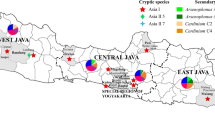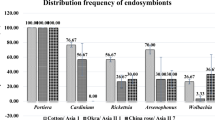Abstract
Secondary endosymbionts of Turkish Bemisia tabaci (Gennadius) (Hemiptera: Aleyrodidae) populations were determined by PCR-based DNA analysis. Experiments were conducted with B. tabaci samples collected from various host plants between 2007 and 2012. Four secondary endosymbionts, namely, Rickettsia, Hamiltonella, Arsenophonus and Wolbachia, were detected from two different B. tabaci species (B and Q). While Arsenophonus and Wolbachia were determined only from the Q, Hamiltonella was found only on the B. Rickettsia was determined on both B and Q. Forty percent of individuals were infected with Arsenophonus, followed by Hamiltonella (32.4 %), and Wolbachia (8 %). Infection rate of Rickettsia was found to be higher on B (29.7 %) than on Q (21.6 %). This study is the first report of endosymbionts of B. tabaci populations collected from Turkey, and studies should be continued to cover larger areas, more host plants and B. tabaci populations.


Similar content being viewed by others
References
Bayhan, E., Ulusoy, M. R., & Brown, J. K. (2006). Host range, distribution, and natural enemies of Bemisia tabaci ‘B biotype’ (Hemiptera: Aleyrodidae) in Turkey. Journal of Pest Science, 79, 233–240.
Bedford, I. D., Markham, P. G., Brown, J. K., & Rosell, R. C. (1994). Geminivirus transmission and biological characterization of whitefly (Bemisia tabaci) biotypes from different world regions. Annals of Applied Biology, 125, 311–325.
Brown, J. K., Frohlich, D. R., & Rosell, R. C. (1995). The sweet-potato or silverleaf whiteflies biotypes of Bemisia tabaci or a species complex. Annual Review of Entomology, 40, 511–534.
Brumin, M., Kontsedalov, S., & Ghanim, M. (2011). Rickettsia influences thermotolerance in the whitefly Bemisia tabaci B biotype. Insect Science, 18, 57–66.
Castle, S. J., Palumbo, J. C., Prabhaker, N., Horowitz, A. R., & Denholm, I. (2010). Ecological determinants of Bemisia tabaci resistance to insecticides. In P. A. Stansly & S. E. Naranjo (Eds.), Bemisia, bionomics and management of a global pest (pp. 423–465). New York: Springer+Business.
Chiel, E., Gottlieb, Y., Zchori-Fein, E., Mozes-Daube, N., Katzir, N., Inbar, M., et al. (2007). Biotype-dependent secondary symbiont communities in sympatric populations of Bemisia tabaci. Bulletin of Entomological Research, 97, 407–413.
Chu, D., Cong, B., Zhang, Y. J., Xu, B. Y., Wu, Q. J., & Zhu, G. R. (2005). Detection and phylogenetic analysis of Wolbachia in different Bemisia tabaci biotypes. Acta Entomologica Sinica, 48, 518–525.
Chu, D., Gao, C. S., De Barro, P., Zhang, Y. J., Wan, F. H., & Khan, I. A. (2011). Further insights into the strange role of bacterial endosymbionts in whitefly, Bemisia tabaci: Comparison of secondary symbionts from biotypes B and Q in China. Bulletin of Entomological Research, 101, 477–486.
Chu, D., Hu, X., Gao, C., Zhao, H., Nichols, R. L., & Li, X. (2012). Use of mitochondrial cytochrome oxidase I polymerase chain reaction–restriction fragment length polymorphism for identifying subclades of Bemisia tabaci Mediterranean group. Journal of Economic Entomology, 105, 242–251.
Dinsdale, A., Schellhorn, N. A., De Barro, P., Buckley, Y. M., & Riginos, C. (2012). Rapid genetic turnover in populations of the insect pest Bemisia tabaci Middle East: Asia Minor 1 in an agricultural landscape. Bulletin of Entomological Research, 102, 539–549.
Duron, O., Bouchon, D., Boutin, S., Bellamy, L., Zhou, L., & Engelstädter, J., et al. (2008). The diversity of reproductive parasites among arthropods: Wolbachia do not walk alone. BMC Biology, 6–27.
Everett, K. D. E., Thao, M. L., Horn, M., Dyszynski, G. E., & Baumann, P. (2005). Novel chlamydiae in whiteflies and scale insects: endosymbionts ‘Candidatus Fritschea bemisiae’ strain Falk and ‘Candidatus Fritschea eriococci’ strain Elm. International Journal of Systematic and Evolutionary Microbiology, 55, 1581–1587.
Ghanim, M., & Kontsedalov, S. (2009). Susceptibility to insecticides in the Q biotype of Bemisia tabaci is correlated with bacterial symbiont densities. Pest Management Science, 65, 939–942.
Gottlieb, Y., Ghanim, M., Chiel, E., Gerling, D., Portnoy, V., Steinberg, S., et al. (2006). Identification and localization of a Rickettsia sp. in Bemisia tabaci (Homoptera: Aleyrodidae). Applied and Environmental Microbiology, 72, 3646–3652.
Gottlieb, Y., Zchori-Fein, E., Mozes-Daube, N., Kontsedalov, S., Skaljac, M., Brumin, M., et al. (2010). The transmission efficiency of Tomato yellow leaf curl virus by the whitefly Bemisia tabaci is correlated with the presence of a specific symbiotic bacterium species. Journal of Virology, 84, 9310–9317.
Gueguen, G., Vavre, F., Gnankine, O., Peterschmitt, M., Charif, D., Chiel, E., et al. (2010). Endosymbiont metacommunities, mtDNA diversity and the evolution of the Bemisia tabaci (Hemiptera: Aleyrodidae) species complex. Molecular Ecology, 19, 4365–4376.
Heddi, A., Grenier, A. M., Khatchadourian, C., Charles, H., & Nardon, P. (1999). Four intracellular genomes direct weevil biology: Nuclear, mitochondrial, principal endosymbiont, and Wolbachia. Proceedings of the National Academy of Sciences of the USA, 96, 6814–6819.
Karut, K., & Akdağcık, Z. (2006). Determination of parasitism status of Bemisia tabaci (Gennadius) (Homoptera: Aleyrodidae) in cotton fields in Çukurova. Turkish Journal of Entomology, 30, 33–41 (in Turkish, with English abstract).
Karut, K., & Naranjo, S. E. (2009). Mortality factors affecting Bemisia tabaci populations on cotton in Turkey. Journal of Applied Entomology, 133, 367–374.
Karut, K., Malik, A. A. Y., Kazak, C., Kamberoğlu, M. A., & Ulusoy, M. R. (2012). Determination of biotypes of Bemisia tabaci Gennadius 1889 (Hemiptera: Aleyrodidae) on different host plants in Adana (Balcalı) by using two different molecular methods. Turkish Journal of Entomology, 36, 93–100 (in Turkish, with English abstract).
Karut, K., Kaydan, M. B., Castle, S. J., Kazak, C., & Ulusoy, M. R. (2013). Study on biotype composition of Bemisia tabaci (Gennadius) (Hemiptera: Aleyrodidae) on cotton in Çukurova Plain, Turkey. First International Whitefly Symposium (p. 137). Crete: Kolymbari.
Kontsedalov, S., Zchori-Fein, E., Chiel, E., Gottlieb, Y., Inbar, M., & Ghanim, M. (2008). The presence of Rickettsia is associated with increased susceptibility of Bemisia tabaci (Homoptera: Aleyrodidae) to insecticides. Pest Management Science, 64, 789–792.
Li, Z. X., Lin, H. Z., & Guo, X. P. (2007). Prevalence of Wolbachia infection in Bemisia tabaci. Current Microbiology, 54, 467–471.
Nirgianaki, A., Banks, G. K., Frohlich, D. R., Veneti, Z., Braig, H. R., Miller, T. A., et al. (2003). Wolbachia infections of the whitefly Bemisia tabaci. Current Microbiology, 47, 93–101.
Özgur, A. F., & Şekeroglu, E. (1986). Population development of Bemisia tabaci (Homoptera: Aleyrodidae) on various cotton cultivars in Çukurova, Turkey. Agriculture, Ecosystems and Environment, 17, 83–88.
Özgür, A. F., Şekeroglu, E., Ohnesorge, B., & Göçmen, H. (1989). Studies on the population dynamics of Bemisia tabaci Genn. (Homoptera: Aleyrodidae) in Çukurova, Turkey. Journal of Applied Entomology, 107, 217–227.
Pascual, S., & Callejas, C. (2004). Intra- and interspecific competition between biotypes B and Q of Bemisia tabaci (Hemiptera: Aleyrodidae) from Spain. Bulletin of Entomological Research, 94, 369–375.
Şengonca, Ç. (1975). Bietrag zum epidemischen Auftreten der Tabakmottenschildlaus, Bemisia tabaci, an Baumwollpflanzen in Südanatolien (Homoptera: Aleyrodidae). Anzeiger für Schadlingskunde, Pflanzenschutz, Umweltschutz, 48, 140–144.
Stansly, P. A., & Naranjo, S. E. (2010). Introduction. In P. A. Stansly & S. E. Naranjo (Eds.), Bemisia, bionomics and management of a global pest (pp. VX–XVIII). New York: Springer+Business.
Thao, M. L., & Baumann, P. (2004). Evidence for multiple acquisition of Arsenophonus by whitefly species (Sternorrhyncha: Aleyrodidae). Current Microbiology, 48, 140–144.
Tsagkarakou, A., Mouton, L., Kristoffersen, J. B., Dokianakis, E., Grispou, M., & Bourtzis, K. (2012). Population genetic structure and secondary endosymbionts of Q Bemisia tabaci (Hemiptera: Aleyrodidae) from Greece. Bulletin of Entomological Research, 102, 353–365.
Weeks, A. R., Velten, R., & Stouthamer, R. (2003). Incidence of a new sex-ratio-distorting endosymbiotic bacterium among arthropods. Proceedings of the Royal Society Series B, 270, 1857–1865.
Acknowledgments
The authors would like to thank Dr. Steven J. Castle (ARS, ALARC, USDA, Maricopa, AZ, USA) for editing the manuscript. We also thank Dr. Cengiz Kazak, Dr. Bora Kaydan (Çukurova University) and the anonymous reviewers for their comments.
Author information
Authors and Affiliations
Corresponding author
Rights and permissions
About this article
Cite this article
Karut, K., Tok, B. Secondary endosymbionts of Turkish Bemisia tabaci (Gennadius) populations. Phytoparasitica 42, 413–419 (2014). https://doi.org/10.1007/s12600-013-0378-x
Received:
Accepted:
Published:
Issue Date:
DOI: https://doi.org/10.1007/s12600-013-0378-x




